Torres Spanish Restaurant Glasgow
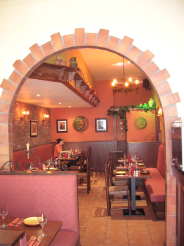 327 Sauchiehall Street, Glasgow, G2 3HU Tel: 0141 332 6789
327 Sauchiehall Street, Glasgow, G2 3HU Tel: 0141 332 6789
A fresh take on the great culinary tradition of Spain
Do you know your Cervantez from your cerveza? So many people now holiday in Spain that most Scots probably have at least a passing acquaintance with one of Europe's truly wonderful drinking and dining cultures.
Tapas is the modern Glasgow eating out phenomenon which - having taken just a few centuries to make it to Scotland from sunny Hispana - is definitely going all out to make up for lost time.
Ancestral Spanish snacking culture, it seems, has collided head on with a well-attested vogue for lighter but more varied meals, along with an apparently insatiable consumer demand for "new" cuisines.
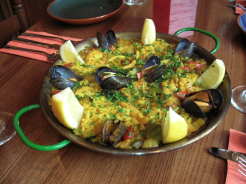 However at Torres the menu is versatile enough to offer you everything from a slimmed-down but enlivening repast to a full, extremely hearty dinner - and it's this versatility which most appeals to customers, along with the variety of the core ingredients.
However at Torres the menu is versatile enough to offer you everything from a slimmed-down but enlivening repast to a full, extremely hearty dinner - and it's this versatility which most appeals to customers, along with the variety of the core ingredients.
Recent years have seen the launch in west Glasgow of Moroccan and Turkish restaurants, as a point of difference to the city's still incredibly-vibrant Indian dining scene, and it can be interesting to compare some of the better-known North African/Turkish dishes with one or two of the typical entries you find on a tapas list - for example Turkish cuisine, while seldom spicy, does contain an incendiary sausage strongly redolent of its Spanish chorizo cousin
There's no real mystery in this partial overlap of cultures, of course. The Ottoman Turkish culinary reach was even wider than the limits of its great empire - whose progress was brought to a shuddering halt by Spain at the great sea battle of Lepanto in 1571 - while Spanish links with Morocco (and hence the Berbers, who conquered much of Spain in the 8th century) began in earnest with Hannibal nearly 2,000 years earlier.
When you consider that all Moorish rule in Spain was only finally ended in the closing years of the 15th century it's small wonder there's a North African twist to some Spanish dishes you seldom encounter in the more "European" traditional fare of, say, southern France - where food is, broadly speaking, either French or immigrant Arab.
In Spain the influence of ancestral Moorish Granada or Cordoba is still as potent in the food as it is in great Spanish music: architecture and cuisine, it seems, are eternal legacies of long-term occupation of a country by any truly great culture - and Moorish style cuisine, or elements within it, had around eight centuries to take root in Spain.
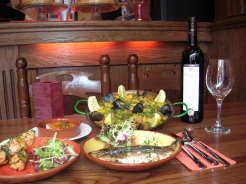 Yet another external influence became part and parcel of the Spanish dining repertoire with 16th century conquests in the New World, which brought chilli peppers and other exotic ingredients (including potatoes, no longer exotic but still very tasty) to Spain from the Americas.
Yet another external influence became part and parcel of the Spanish dining repertoire with 16th century conquests in the New World, which brought chilli peppers and other exotic ingredients (including potatoes, no longer exotic but still very tasty) to Spain from the Americas.
Why Tapas?
Tapas, literally "to cover" - from pieces of bread once used to keep fruit flies from drowning in one's glass of sherry - is said to have been popularised by King Alfonso the Wise of Castile (d.1284), with enterprising tavern keepers later elaborating the original basic snack into a whole range of far more ambitious dishes.
All this is a long way of saying there's no such thing as a generic "Spanish cuisine" - and therefore no need for there to be a "standard" Spanish restaurant. While there are obviously several typical menu entries - fine Serrano ham, for example - Spain also has an infinite capacity to innovate, refine and surprise.
So when new tapas venture Torres opened recently in its prime spot on Sauchiehall Street there was literally everything to play for in dining terms: in such a key location you'd expect it to be seeking to impress.
Spanish Towers
We're invited by the management of Torres to decide for ourselves which "towers" (Torres) the restaurant's name refers to. It could be the towers of Trinity and the former Park Church, above nearby Kelvingrove - or it may be the twinned gastronomic delights of enticing food with great wine, around which all civilised Spanish life revolves.
The restaurant itself is modelled, naturally enough, on a classic Hispanic bodega, and while modest in size its natural wood finishes and terracotta surrounds - decorated with pictures depicting classic Spanish themes such as bullfights and flamenco dancers - makes for a relaxing setting for a convivial lunch or a romantic evening assignment for two.
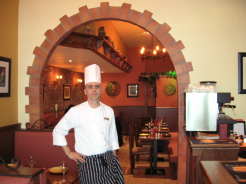 What with the engraved (with bulls) picture windows, comfortable booths and tiled floor it's an attractive contemporary take on a classic traditional theme.
What with the engraved (with bulls) picture windows, comfortable booths and tiled floor it's an attractive contemporary take on a classic traditional theme.
The charming and attentive staff ensure you also get a typically warm Iberian-style welcome, and evidently don't mind explaining the nuances of this dish or that for the umpteenth time.
It's the Spanish chefs in the kitchen, however, who are the real culinary conquistadores in this hitherto tapas-free stretch of the city.
Rather than bamboozle customers with a catalogue of options the menu selection is both easy to understand and also an excellently-balanced representative sample of everything that is glorious about Spanish cuisine.
The aim has been to offer a broad range of choices while maintaining the sort of quality you expect from a cook-from-scratch kitchen.
Another way Torres will arguably score with many customers is in its "and wine bar" tag, which is borne out with a wide selection of Spanish (and also Italian and new World) wines, both by the bottle and by the glass.
It depends what sort of mood you are in, of course - another popular choice (besides all the usual Scottish favourites, eg Tennent's Lager) is time-honoured "holiday lager" San Miguel. Originally from the Phillippines, this is easily the best-known Spanish beer (other main brands include Mahou, Cruzcampo and Damm, centred respectively on Madrid, Seville and Barcelona: Spanish San Miguel is brewed in Malaga and Lerida) and is arguably as good an accompaniment to a meal as any.
It's important to realise that the word "restaurant" is carefully chosen, meanwhile, as Torres offers a great deal more than just a selection of exotic snacks: its paella, for example (which takes around 35-40 minutes to prepare) is a creation which involves real expertise and flair as well as time and careful preparation ... and is reportedly well worth trying: you can try a lighter tapas option or two while you wait for it to arrive.
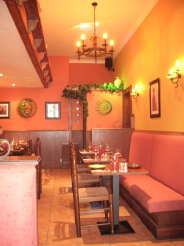 However for most people the temptation to explore as many of the main menu's tapas varieties as possible will take precedence, at least for the first few visits.
However for most people the temptation to explore as many of the main menu's tapas varieties as possible will take precedence, at least for the first few visits.
There simply aren't any rules to which dishes you decide to mix and match - or whether, indeed, you have to let your dining partner sample any of your choices: a typical meal would probably be accompanied by bread (several kinds here) and salad - but nobody will complain if you decide to concentrate on the Carne (meat) or Marisco (seafood) options.
We're promised by the management that Torres provides fresh food daily, from premier local suppliers, and of course there's a full range of famous Spanish products - for example Manchego, sheep's milk cheese from La Mancha; as well as sardines, squid, and other Mediterranean staples.
But now let's have a closer look at the full menu ... .






